If we are on the same page, then we can both agree that living near a main street or freeway has its drawbacks. I happen to live near the main freeway.
This means that I get the luxury of listening to all the traffic noise from my backyard and living room.
If you are inside your home and are bothered by the outside road noise, then you may want to learn how to soundproof a window first before going to your backyard.
That is the first step that I took to get rid of the obnoxious outdoor noises that were coming into my home.
Back on topic, sometimes the big walls that cities build are not enough to stop all the noises that flow freely into your backyard.
Sometimes the noise isn’t from a freeway but coming from the main street instead. So what exactly can you do about it?
While there is no way to completely stop the noise altogether, there are many things you can do to either deflect or absorb the sound.
Reducing Traffic Noise: Sound Deflection vs. Sound Attenuation
Sound deflection is when you actually deflect the incoming sound using some type of barrier.
This is the most effective way to reduce sound, but it is a lot more work and expensive to perform.
The other method, which is a more common solution, is sound attenuation. This basically means that you will lower the intensity of the sound coming through by absorbing it.
Sound deflection requires you to install solid barriers that perform well at deflecting sound. Most of these items are solid, robust, and very costly.
Sound attenuation uses items that are less solid, meaning sound is still able to pass through them. These items tend to be on the cheaper side due to the types of materials being used.
Plant Hedges Around Your Backyard
Hedges are great for sound attenuation because they are both aesthetically pleasing and affordable.
If you have a garden in your backyard, adding hedges can add a positive look, all while reducing the noise from the street.
Planting hedges around your yard can be costly unless you are willing to do it yourself. Not to mention that you must also wait for the hedges to grow properly into size.
Once your hedges are the proper size, you will then have to worry about maintenance costs.
You will need to either trim the hedges yourself or pay for a gardener to trim them for you. Hedges can be a real nuisance if they are left to grow out of control.
I have found a great alternative to planting hedges. These artificial boxwood hedges from amazon are the best alternative to using real hedges.
They come in a variety of styles and colors to suit almost any need. Although they may seem a little pricey, you will not need to wait for them to grow, and there is almost no maintenance involved since they will not grow.
The overall noise reduction that you can expect from hedges is about 25% which is pretty good.
Brushwood Fences
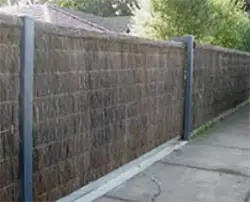
Studies have shown that a fence made of brushwood that is 600 mm or thicker will have sound-reducing qualities.
Brushwood is like the straw house from the three little pigs book. They won’t blow over with heavy wind, but they can be dangerous if a fire were to ever occur in your area.
A brushwood fence also doesn’t look the best. It gives your home an older appearance which most people don’t prefer.
This is one of the cheaper options available to you and also does a great job at absorbing sound since it acts like a sponge for noise.
Wooden Fences
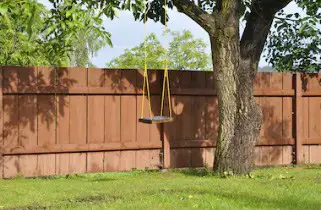
A wooden fence is another great option. If you already have wooden fences installed in your backyard, then you can double up by adding hedges.
Adding another layer to your backyard will help with letting less noise pass into your backyard. If you don’t have a wooden fence, then the best place to find materials is at your local home improvement stores like Lowes or Home Depot.
You might also need to hire a professional to install the fence, which will add to the overall costs.
Wooden fences look a lot more modern and are less prone to catching on fire than a fence that is made of brushwood.
A wooden fence by itself is not the greatest option when it comes to reducing noise. This is mainly due to all the cracks and holes that the sound will be able to travel through.
Metal Fences
A metal fence is a lot more sturdy than a wooden fence but usually lacks in the sound reduction department. A metal fence is the least recommended method to do.
They are also a bad choice for high-wind areas and are not as versatile as the other options I have provided.
Metal fences also tend to damage easily, which will mean a high maintenance cost unless you like the look of a broken or dented fence.
If you have a metal fence, don’t worry because not all hope is lost. Just incorporate a hedge before the fence to double up the layers, similar to if you have a wooden fence.
Two Best Methods for Reducing Traffic Noise in Your Backyard
Brick Walls
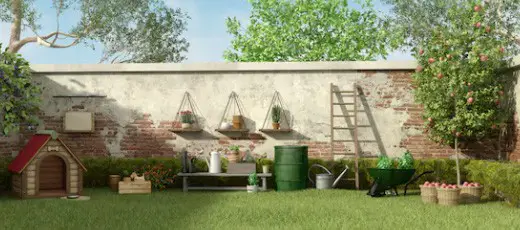
Brick walls are one of the best ways to reduce noise coming into your backyard. A wall made of bricks is also durable and solid, and does an awesome job at blocking anything trying to get through.
There are quite a few downsides to a brick wall. It can be very costly due to how many bricks you need for your wall.
After gathering all the bricks, you then need to find somebody to do the installation unless you are a professional at masonry.
Don’t forget that you will also need to purchase cement in order to build the wall. If you are willing to spend the money for a nice big brick wall, then your efforts will be well rewarded.
A brick wall can reduce noise by up to 50%, which is double what a hedge or fence can do for you.
Modular Walls and Fences
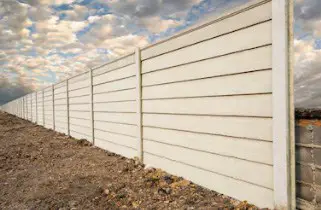
These are one of the top methods right next to using brick walls. Modular walls and fences are unique as they will give you the same kind of sound blocking as a brick wall but at a substantially lower cost.
Modular walls also have a more modern, aesthetically pleasing look than a brick walls. This more or less boils down to personal preference, but the majority of today’s generation will probably prefer modular over brick.
What is a modular wall exactly? There are many different thicknesses of these types of panels, and they all share a common material type.
They are made up of fiber cement outer skins that are laminated to a lightweight EPS core. EPS foam is expanded polystyrene foam which is a version of polystyrene foam.
To put this in normal language, most surfboards are starting to shift over to this type of material. It is lightweight, strong, and durable.
How Strong Is a Modular Wall vs. a Brick Wall?
Modular walls happen to be very strong. They will be able to withstand normal daily use and will not easily dent or bend.
The main benefit is that it is substantially cheaper to build and repair than a brick wall.
This alone will make it worth the cost. It might not be quite as strong as a brick wall, but the benefits you get from a modular wall will outweigh the slight loss in durability.
Create a Raised Hill in Your Backyard
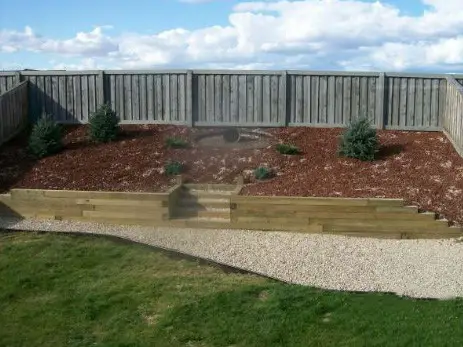
This is a similar approach to how cities build big highways. The next time you are driving down your local freeway that is near houses or stores, you will at some point see raised hills that are usually behind a wall.
If they are not behind a wall, they will most likely have flowers planted all over the dirt to make it more appealing to the eye. Without adding flowers to the dirt, it will just be a big pile of dirt.
The idea is to mimic this approach in your own backyard. Obviously, your raised hill wont be nearly as big as the one you see on a highway, but it will still be very effective at blocking oncoming traffic noise.
In order to do this effectively, you will need to build a fence or wall on the top of the hill as well as have something in the front to block the dirt from flowing into your backyard.
The picture I have provided above shows a very good example of what this will look like. You can plant more vegetation as you see fit.
Some people also like to put wood chips on top of the dirt to change their appearance. With a little bit of imagination, this method can actually provide a more aesthetic look to your backyard.
Add Vegetation to Your Backyard
Adding vegetation, such as big trees and bushes, acts as a natural noise reducer. They also make your backyard look good.
I would highly suggest adding vegetation as an additional step after you have already installed some type of barriers like a wall or fence.
Adding vegetation alone is not very effective by itself. You also need to make sure that they are planted densely enough to where you can’t see over or through them.
Adding a tiny bush that only goes up to your waist will have no benefit in sound reduction whatsoever.
For the best results, I suggest planting one row of tall evergreen trees and then an inner row of evergreen shrubs.
Remember that the more dense your vegetation is, the better it will be at reducing the noise coming through.
Create White Noise
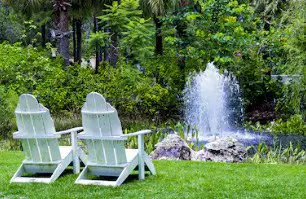
A different option that you can try instead of trying to block or deflect the sound is to drown it out.
Adding a feature to your backyards, like a fountain or a waterfall to your backyard’s landscape, can help drown out the outside noise. You can find these at your local hardware stores available as boxed kits.
This type of method is called creating white noise. Try to install this feature closest to wear you will be planning on spending most of your outdoor time with your family.
Having the fountain or waterfall in a place where you will not be residing at will be counterproductive. A good place to put this is near your backyard furniture.
Another great option for adding white noise is to install a small stream or lake with fish. Just make sure this has some sort of small fountain or waterfall for the white noise. This is both stylish and functional at the same time.
Final Thoughts
Nothing will completely drown out the traffic noise in your backyard. All of these methods will, at best, absorb or block lots of the noise coming through.
The best combination is to first make a small hill in your backyard. Next, add a modular or brick wall to the top of it.
Once that is complete, you can decorate the hill with plants and vegetation to your liking. This combination will most likely yield the best results if your main goal is to try and eliminate the noise altogether.
Your main goal should be to try and have fun with this project. Take the time to map out how you want your backyard to look.
Don’t just throw a bunch of ideas together just because it’s the best way to drown out the noise. There are many different types of combinations that can help drown out traffic noise.
Adding lots of vegetation, fountains, waterfalls, brick walls, modular walls, fences, and any other thick, dense materials will make a huge difference.


